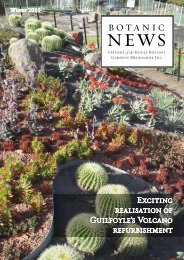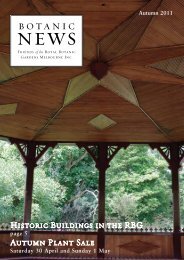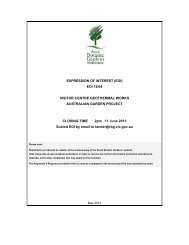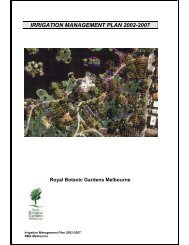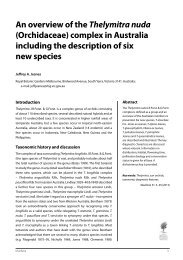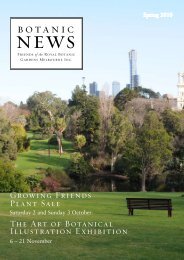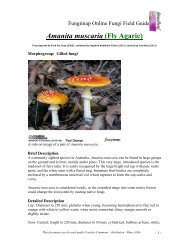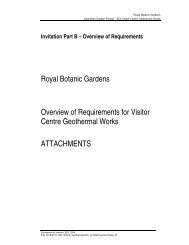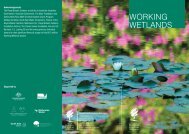Annual Report 2010-2011 (PDF - 2.47 mb) - Royal Botanic Gardens ...
Annual Report 2010-2011 (PDF - 2.47 mb) - Royal Botanic Gardens ...
Annual Report 2010-2011 (PDF - 2.47 mb) - Royal Botanic Gardens ...
Create successful ePaper yourself
Turn your PDF publications into a flip-book with our unique Google optimized e-Paper software.
Contents<br />
OUR achievements – Strategic Priority 2C<br />
Specific Outcome Measure Result<br />
34 (Display<br />
wild-collected<br />
plant species)<br />
Areas planted with indigenous<br />
plant species are maintained to<br />
high curatorial standards<br />
Indigenous plant species are<br />
considered and used where<br />
appropriate when developing<br />
areas of RBG Melbourne<br />
Victorian indigenous plant species were<br />
planted into the Rare and Threatened<br />
Species Beds, Australian Forest Walk,<br />
Herbarium Bed, and Conifer Border.<br />
35 (Environmental<br />
weed education,<br />
eradication and<br />
management)<br />
A collaborative project with the<br />
Department of Primary Industries<br />
(DPI) for a molecular identification<br />
tool for stipoid grasses, which pose<br />
a biosecurity threat for Victoria,<br />
developed<br />
A molecular identification tool for stipoid<br />
grasses was developed and used to<br />
identify batches of Mexican Feather grass,<br />
thereby thwarting a potential threat to<br />
Victoria’s biosecurity.<br />
36 (RBG<br />
Cranbourne<br />
remnant<br />
vegetation<br />
management<br />
program)<br />
Conservation Zone vegetation<br />
maintained at ‘high quality’ status<br />
Management strategies were implemented<br />
including a grassy weed control program<br />
and prescribed burns conducted.<br />
(See Specific Outcome 36 for further<br />
details.)<br />
37 (Grassy<br />
woodland weed<br />
control)<br />
Vegetation survey data shows a<br />
reduction in the cover abundance<br />
of grassy weed species<br />
Environmental weed control continued;<br />
however, due to competing priorities,<br />
vegetation survey data collection was<br />
insufficient to determine abundance trends.<br />
38 (Global Strategy<br />
for Plant<br />
Conservation)<br />
Priority plant identifications provided in<br />
a collaborative effort with DPI to assess<br />
and monitor the spread of new and<br />
emerging weed species<br />
The Plant Identification and Information<br />
Service provided the DPI with priority<br />
identifications of suspected new and<br />
emerging weeds.<br />
39 (Millennium<br />
Seed<br />
Bank and<br />
Victorian<br />
Conservation<br />
Seedbank<br />
partnership)<br />
Nu<strong>mb</strong>er of species for which seed has<br />
been collected as part of the Victoria<br />
Conservation Seedbank initiative<br />
(measured against previous years)<br />
In <strong>2010</strong>–11, the Victorian Conservation<br />
Seedbank sent 239 seed lots (74 of them<br />
new) to the <strong>Royal</strong> <strong>Botanic</strong> <strong>Gardens</strong>, Kew.<br />
Duplicate collections are held in long-term<br />
storage at the <strong>Royal</strong> <strong>Botanic</strong> <strong>Gardens</strong><br />
Melbourne. In 2009–10, 164 seed<br />
collections were made, and in 2008–09<br />
165 collections were made.<br />
<strong>Royal</strong> <strong>Botanic</strong> <strong>Gardens</strong> Board Victoria <strong>Annual</strong> <strong>Report</strong> <strong>2010</strong>–11 page 81




